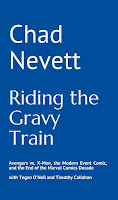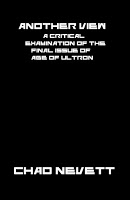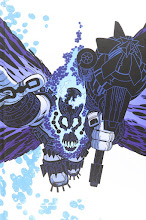In my quest to look at Morrison's post-Flex Mentallo superhero work, I read the entire Seven Soldiers story yesterday (with the three-part JLA Classified prologue the night before).
But, before I no doubt write the shortest blog post on the entire thing in the history of the web, I'll direct you to a few places that discuss the entire series in far more intelligent ways:
Jog's reviews
Greg Burgas' 31 Days of Seven Soldiers
Barbelith's Seven Solders Wiki
Now then, my overall impression of the entire saga was a somewhat lacklustre, apathetic one. At least with regards to what each character does to fight the Sheeda. It's rather interesting, but most of them seem to do little minor things. Mister Miracle, for example, does nothing to fight the Sheeda. Sure, he frees Aurackles, but how does that fight the Sheeda? Jog speculates that he's not even one of the Seven Soldiers really, which makes sense. The Manhattan Guardian does some fighting of Sheeda warriors at the end, but his only other contribution (that I can see) is being on the train that runs over the Horrigal and lets Klarion escape.
Now, I actually like that some of the characters don't seem to do much--or, the things they do to help are only minor elements of their stories. The Bulleteer is the key to killing Glorianna, but beyond that, she does nothing (except not show up in Seven Soldiers #0). Except everything she does leads her to driving that car in Seven Soldiers #1.
In a way, the whole series is about coincidence and how seemingly meaningless moments build to create meaningful actions.
Another theme that I picked out (and was slightly touched on, sort of, by Burgas, mostly in his child/adult theme) was one that I saw in Flex Mentallo (and can see in almost everything else Morrison does): the tension between past and future. Now, I'm leaving the present out of it, because the present is, ultimately, transient and meaningless. Here, the conflict is between the past (now) and the future (the Sheeda)--both are the present depending on the perspective.
Justin(a) struggles between the past and future as (s)he acclimates to our time.
The Guardian struggles between his past of killing an innocent teen and his future as a hero.
Zatana struggles between her past as a fuck-up and her future as a confident hero.
Klarion struggles between the past his people are trapped in and the future of our world.
Mister Miracle struggles between the New Gods' past and future.
Bulleteer struggles between her past and future lives.
Frankenstein doesn't actually struggle, he just acts the same no matter what time it is despite being from a past time.
And, of course, all of these series have a tension between old characters and new, same with the name Seven Soldiers. There's even a tension between the first group we see in issue 0 and the seven we follow in their series.
Stylistically, Morrison walks the fine line between the past creators/styles of these books and making them modern. The best example of this is in Mister Miracle where Morrison updates Kirby's New Gods. Or in some of the narration found in The Manhattan Guaradian (very bombastic) or Frankenstein (pulpy). Each of the series has its own unique take on the superhero genre itself, creating a tension between what he's doing with it and what's come before.
Now, the finale of the saga, issue one. It falls victim to the typical Morrison ending in that it isn't actually that satisfying. I've discussed this briefly before, arguing that Morrison doesn't give conclusive endings because of the superhero comic's nature. The nature of the medium/genre is serial, meaning the story never ends. You'll notice this sort of ending in most of his work: Animal Man, JLA, New X-Men, etc. The ending never feels like an ENDING, because it's not. These characters keep going and will have new adventures. The same thing happens here. We see a few of the characters have endings, of sorts, to their adventure (Klarion becomes leader of the Sheeda, Justina is put in a superhero school, Mister Miracle comes back from the dead, and--uh--that's it), but always with an eye toward the future.
That's where the tension between past and future usually shows up in a way that readers don't like, because it's not a satisyfing way to end stories. Morrison recognises that once he's finished the comic, it's continuity past and is always mindful of the future stories that WILL be told. Hell, that was the whole point of the "Planet X" storyarc basically.
And that's what I took from the series. Oh, and might I once again state how mindblowing J.H. Williams III's art on issue one is? Seriously, he does, what, eleven different styles? Sometimes three or four styles on a single page. And you'll note no Eisner nomination. The fuck? Show me art that is more impressive and well done in the past year. You can't.
Next up in my journey through Morrison's post-Flex Mentallo work (which I've dubbed "The Next Age" for easy reference) is Seaguy. I'm not doing these in any real order, just whatever I feel like. After that, some thoughts on Fantastic Four 1234. By then, I should be finished his JLA run (just began "Rock of Ages").
skip to main |
skip to sidebar
"Chad Nevett is the spicy mustard of comics reviews" -- Adam Langton, Lovable Fucker and Chad Nevett's Best Man
About
GraphiContent was a blog featuring comic criticism, commentary, analysis, theory and discussion. Oh, and the odd rant, review or totally random post.
Chad Nevett has a BA in English and political science, and an MA in English Language & Literature--Creative Writing. He was a reviewer for Comic Book Resources, blogger for Comics Should be Good, and writer for 411mania. He resides in Windsor, Ontario with his wife and her cat. He can be reached at chevett13[at]yahoo[dot]ca.
Notable Posts (In Chronological Order)
- The Future is X-Rated: Marvel Boy, the Modern World, and the History of the Marvel Universe
- A Music Video on Paper: The Final Chapter of Codeflesh
- Tony Stark, Futurist
- "All you need is fuck."
- Man v. Superman
- Civil War v. Infinite Crisis
- Building a Better Batman: Grant Morrison's First Year on Batman
- U.S. v. T.H.E.M. with Little Ol' Me Stuck in the Middle
- Mark Millar's Ultimate X-Men
- Building a Better Batreader: Grant Morrison's Second Year on Batman
- Secret Invasion Reading Order (Updated June 29, 2013)
- Top 25 Warren Ellis Comics (Oct. 2009)
- Building a Better Batfamily: Grant Morrison's Third Year on Batman (and Robin)
- You Don't Just Want to Break Me, You Want to Tear Me Apart
- 50 Things I Learned in My Three Years and Four Months as a Reviewer for Comic Book Resources
- Avengers vs. X-Men Reading Order (Updated August 17, 2013)
Notable Collections of Posts (In Semi-Chronological Order)
- Joe Casey Comics Archive
- Countdown to Who Cares?
- The Chad and Steve Q&A Series
- I've Got 52 Problems, but a Bitch ain't One
- Best of 2007
- Hello Cosmic: The Works of Jim Starlin Archive
- Chad's Jackass Comic Creator Interviews from 2001
- The Superman 2000 Pitch (with Tim Callahan)
- Raymond Chandler's "Twelve Notes on the Mystery Story"
- Best of 2008
- Blogathon 2009: Brian Michael Bendis's Avengers
- Best of 2009
- Art Discussion Month 2010
- Five Years Blogging: A Life Well Wasted (with David Brothers)
- Booze, Broads & Bullets: Sin City
- Blogathon 2010: Hellblazer (and Hellblazer Posts Beyond the Blogathon)
- Best of 2010
- 28
- Blogathon 2011: Superhero Comics of the Past Decade
- Best of 2011
- Riding the Gravy Train (Avengers vs. X-Men) Archive
- Blogathon 2013: Comics Critics All-Stars
- Best of 2012
Links
Blogs Worth Reading
-
-
The X-Axis – w/c 15 April 20248 hours ago
-
-
-
-
The Mighty Crusaders Number Four #031 month ago
-
The Last Thorsday1 month ago
-
Everybody’s Rockin’6 months ago
-
-
Social (Science) Fiction8 months ago
-
The Rest of the Cruise1 year ago
-
-
-
-
Untitled 1:5 years ago
-
Farewell, sweet prince6 years ago
-
Hello World6 years ago
-
-
-
That’s a wrap.9 years ago
-
episode 026: exit the world10 years ago
-
-
Books Read in 201211 years ago
-
Building Stories - Suggested Reading Order11 years ago
-
Final Crisis #715 years ago
-
Riding the Gravy Train: Avengers vs. X-Men, the Modern Event Comic, and the End of the Marvel Comic
Another View: A Critical Reading of the Final Issue of Age of Ultron
GØDLAND CELESTIAL EDITION THREE
Shot in the Face: A Savage Journey to the Heart of Transmetropolitan
Keeping the World Strange: A Planetary Guide
Minutes to Midnight: Twelve Essays on Watchmen
Writing Without Direction: 10 1/2 Short Stories by Canadian Authors under 30
Blog Archive
-
▼
2007
(252)
-
▼
May
(17)
- the Plastic Man/Spirit abstract
- Thoughts On August's Comics
- I . . . I think I'm killing comics . . . (not real...
- Man V. Superman
- One, two, three, four, get your woman on the floor!
- guest lecture on audio
- No Love Lost for Loveless
- We can drive it home with one headlight . . .
- Losers
- As I was going to St. Ives, I met a man with seven...
- Another Abstract--Fostering Critical Thinking with...
- The Next Age
- Shameless Self-Promotion
- "All you need is fuck."
- Be on my side or be on your side
- I had the Hypertime of my life
- In an interstellar burst, I'm back to save the uni...
-
▼
May
(17)






